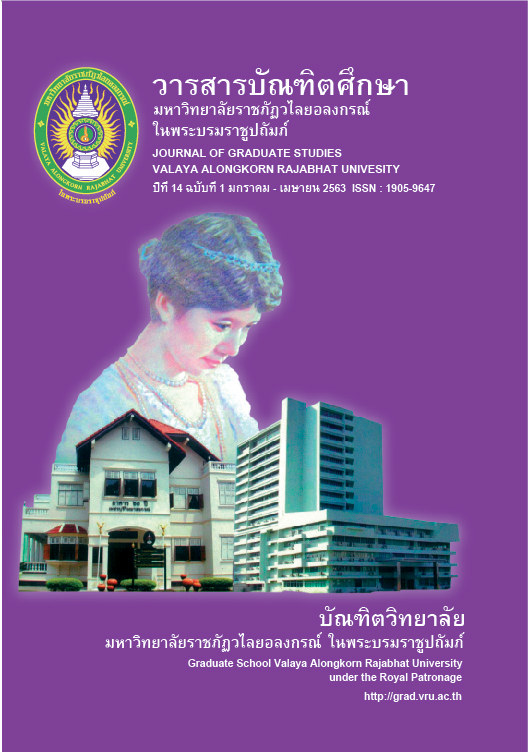RESULT OF MULTIMEDIA LEARNING ON MUSHROOM LIFE CYCLE TO RAISE THE AWARENESS OF MUSHROOM CONSERVATION IN THE AREA OF THE PLANT GENETIC CONSERVATION PROJECT UNDER THE ROYAL INITIATIVE OF HER ROYAL HIGHNESS PRINCESS MAHA CHAKRI SIRINDHORN, THE UNIVERSITY OF
Main Article Content
Abstract
This research had the purposes as following: 1) to develop multimedia learning on mushroom life cycle in order to raise the awareness of mushroom conservation in the Area of the Plant Genetic Conservation Project under the Royal Initiative of Her Royal Highness Princess Maha Chakri Sirindhorn, 2) to pilot multimedia learning on mushroom life cycle with students in grade 6, 3) to study the students’ satisfaction towards multimedia learning on mushroom life cycle, and 4) to publish multimedia learning on mushroom life cycle to the community. The sample groups were 56 students in grade 6 and 56 students’ parents. The sample groups were selected by using multistage stage sampling technique. The instrument used were multimedia learning on mushroom life cycle for students in grade 6, multimedia learning on mushroom life cycle for parents, evaluation form on the awareness of mushroom conservation for students, evaluation form on the awareness of mushroom conservation for parents, the assessment for students’ satisfaction towards multimedia learning on mushroom life cycle. Data analyses were mean, and standard deviation.
The results showed as following:
- The development of multimedia learning on mushroom life cycle rose the awareness of mushroom conservation. In term of students, they could be divided into 7 points, namely 1) general knowledge of mushrooms, 2) life cycle and various parts of mushrooms, 3) types of mushrooms, 4) nutrient of mushrooms, 5) local mushrooms, 6) human’s actions that affect the extinction of mushrooms, and 7) mushroom conservation.
- The results of using multimedia learning on mushroom life cycle with students in grade 6 after the class at a high level (
= 4.36, S.D. = 0.50).
- The result of students’ satisfaction towards multimedia learning on mushroom life cycle at a high level (
= 4.43, S.D. = 0.66).
- The parents of students had an average score of awareness after using at a high level (
= 4.41, S.D. = 0.50).
Article Details

This work is licensed under a Creative Commons Attribution-NonCommercial-NoDerivatives 4.0 International License.
บทความทุกเรื่องได้รับการตรวจความถูกต้องทางวิชาการโดยผู้ทรงคุณวุฒิ ทรรศนะและข้อคิดเห็นในบทความ Journal of Global of Perspectives in Humanities and Social Sciences (J-GPHSS) มิใช่เป็นทรรศนะและความคิดของผู้จัดทำจึงมิใช่ความรับผิดชอบของบัณฑิตวิทยาลัย มหาวิทยาลัยราชภัฏวไลยอลงกรณ์ ในพระบรมราชูปถัมภ์ กองบรรณาธิการไม่สงวนสิทธิ์การคัดลอก แต่ให้อ้างอิงแหล่งที่มา
References
Boonyindee, P. (1993). khwām tranak nai kānkamnot læ nam phǣn phatthanā ʻamphœ̄ mā patibat khō̜ng nāiʻamphœ̄ [Awareness of establishing and implementing the district development plan of the sheriff]. Tearm paper, National Institute of Development Administration.
Chansrikul, A. (1996). khwāmlāklāi khō̜ng het læ rā khanāt yai nai prathēt Thai [The variety of mushrooms in Thailand]. Bangkok: Kasetsart University Press.
Chimmanee, S. (2013). kānphatthanā botrīan khō̜mphiutœ̄ mantimīdīa kān ʻā nawi chā phāsā ʻAngkrit khō̜ng nakrīan chan prathomsưksā pī thī hā rōngrīan wat bāng chāng tai [The development of computer multimedia instruction on English reading for prathomsuksa 5 students at Watbangchangtai School]. Veridian E-Journal, 6(2), 113-125.
Jarinrattanakorn, W. (2001). kānpœ̄trap khāosān khwām tranak læ kānmī sūanrūam nai kānʻanurak dō̜n hō̜i lō̜t khō̜ng prachāchon nai khēt ʻamphœ̄ mư̄ang čhangwat samut songkhrām [Media exposure, awareness, and participation in razor clams conservation project among people in Muang district, Samut Songkhram province]. Master’s thesis, Chulalongkorn University.
Kamprathuang, N. (2015). kānphatthanā krabūankān sāng khwām tranak rū nai kānʻanurak pāmai dōi chai sư̄ khōtsanā nang san nakrīan chan prathomsưksā pī thī 6 [The Development of Forest Conservation Awareness Creating by Using the Short Film Advertising Media for Primary School Grade 6 Students]. Master’s thesis, Mahasarakham University.
Phara, S. (2007). sapphayākō̜n thammachāt læ singwǣtlō̜m (Phim khrang thī 1). [Natural resources and the environment. (1st ed.)]. Bangkok: Expernet.
Plant genetic conservation project under the royal initiation of her royal highness princess maha chakri
sirindhorn. (2011). phǣn mǣbot RSPG. raya hā pī thī hā (Tulākhom Phō̜.Sō̜. sō̜ngphanhārō̜ihāsipsī Kanyāyon Phō̜.Sō̜. 2559) (Phim khrang thī 1) [The master plan of RSPG, a period of five years, the fifth year of the plan (October, 2011-September, 2016). (1st ed.)]. Bangkok: Work Square Co.,ltd.
Rogers, E. M. (1978). Traditional midwives as family planning communication in Asia. Honolulu: The East West Communication Institute. Retrieved from https://rh.anamai.moph.go.th/all_file/yfhs/YFHS%20ความก้าวหน้าที่ท้าทาย.pdf.
Sangthong, S. (n.d.). khwāmrū bư̄angton kīeokap het. [Basic knowledge about mushrooms]. Retrieved from https://www.simuang.ac.th/vichakhan/somchai/content_2.html.
Sangsawang, N. (2014). phonkānchai sư̄ khō̜mphiutœ̄ chūai sō̜n phāsā ʻAngkrit thī nēn nithān khunnatham phư̄a songsœ̄m khwāmsāmāt nai kān ʻān phāsā ʻAngkrit læ khwām tranak rū dān khunnatham nakrīan chan prathomsưksā pī thī hok rōngrīan sakon witthayā sāmphrān čhangwat Nakhō̜n Pathom [Effects of englisg computer assisted language learning focusing on ethical folftales on English reading ability morality awareness of Pratomsuksa six students of Sakolwittaya school, Sampran district, Nakhon Pathomprovince]. Master’s thesis, Silpakorn University.
Suthamkij, N. (2008). panhā sapphayākō̜n thammachāt nai prathēt Thai [Natural resource problems in Thailand]. Document, 1(2551), 1.


